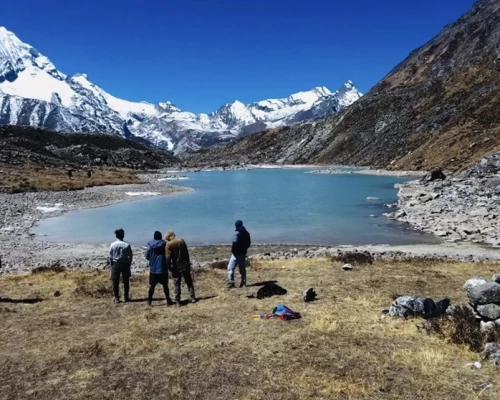Tsho Rolpa Lake Trek is well-known for its beautiful terrain and remote alpine views. The lake lies at an altitude of 4,580 meters / 15,026 feet. located in eastern-central Nepal. It is a breathtaking trek across Nepal's Rolwaling Valley.
The lake is near the Tibet border and the Solukhumbu Region. It lies in between the magnificent Everest and Langtang mountain ranges. Tsho Rolpa is one of Nepal's largest glacial lakes.
This hike takes place in Nepal’s Rolwaling Valley, in the Dolakha district west of the Khumbu area. It covers around 115 miles in 8 to 10 days depending upon the itinerary, and reaches its highest peak at 4508m (14,895 ft). It is situated in the Gaurishankar Conservation Area (GCA).
The trek takes through difficult routes and high mountain passes such as Lapcha Pass. Trekkers can see amazing views of snow-capped mountains i.e. Gaurishankar(7,134m / 23,405ft), Melungtse(7,181m / 23,559ft), Dorje Lapka (6,966 m / 22,854 ft), and Everest ranges.
Hike to Tsho Rolpa Lake provides interaction with Local Sherpa and Tamang communities. That helps to experience unique practices and ways of life in those communities.
Reaching the lake
The trek usually starts from Dolakha. Traveling from Kathmandu to Chhetchhet, beginning a hike from Simi Gaun, to Dongang, and acclimatizing at Naa Gaun through Bedding makes you finally reach the magnificent Tsho Rolpa Lake.
Exploring a variety of biodiversity in the Guarishankar Conservation Area. This trail includes 16 varieties of Flora and 368 species of Fauna including some rare and endangered species. Rare species like Red Panda, Snow Leopard, Pangolin, Himalayan Tahr, and gray wolves. The scenic ride is enriched by the Tama Koshi River.

Tsho Rolpa Trek Cost Breakdown
This hike usually costs $600-800 per person. The number of trekkers, guides, porters, food, permits, and accommodations determine the price of the hike. This excursion is one of the best short trips at reasonable costs for every vivid trekker.
If you choose to hire just a guide and carry your gear, the costs can break down throughout the journey.
| No. of Pax | Costs |
|---|---|
| For 2-4 | $799 |
| For 5-8 | $649 |
| For 9-12 | $599 |
Tsho Rolpa Lake Trek: Is it right for me?
This trip is almost right for everyone with moderate physical fitness. The 9-day walking journey is not physically and technically challenging. However, you need to be careful about wearing warm clothes and your diet plan should also be ensured to keep you healthy.
As this trekking trail does not have any kind of luxury facilities, you need to stay in a basic guest house. But in case of any emergency that needs rescue then helicopters are available on call.
Additionally, this trek has one of the most reasonable costs than other trekking routes in Nepal. So this vacation at an affordable price, the 11-day trek is right for you.
Trekking Seasons
Spring (March- April- May) and Autumn (September- October- November) are the best seasons for the trek. You will experience beautiful skies and moderate temperatures and witness rhododendron blossoms in the springtime.
You can see similar ideal conditions in autumn. The brilliant fall colors enhance the breathtaking scenery. The best trekking conditions and visibility of the neighboring peaks make these times of the year quite popular. It is less recommended in the winter due to the low temperatures and the possibility of snowfall.
Yet, Trekking is possible all year round. There are difficulties during the monsoon season (June- July- August). It is due to severe rainfall and poor visibility.

Cultural Immersion
Trekkers can engage with the local way of life. Passing through traditional Sherpa communities on the trek, you can explore low Himalayan settlements.
You will see unique culture, architecture, and monastic traditions throughout the hike. Engaging with the locals and exploring the colorful Buddhist rites performed in monasteries. You will see their use of prayer flags and carved mani stones.
Book Tsho Rolpa Lake Trek
Our fixed departure dates are for group joining and you may pick any of your suitable dates if you are looking group, or if you are in your own group, you can request a private group trip.
For Quick information / quick answers: Contact Us at WhatsApp: +977 9851083619 ( Ram Krishna Timalsina ), +977 9869489596 or drop us an inquiry at i[email protected].



